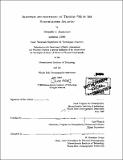| dc.contributor.advisor | Carl Wunsch. | en_US |
| dc.contributor.author | Jeunhomme, Gwenaëlle C | en_US |
| dc.contributor.other | Woods Hole Oceanographic Institution. | en_US |
| dc.coverage.spatial | l------ | en_US |
| dc.date.accessioned | 2010-05-27T19:46:03Z | |
| dc.date.available | 2010-05-27T19:46:03Z | |
| dc.date.issued | 1999 | en_US |
| dc.identifier.uri | http://hdl.handle.net/1721.1/55325 | |
| dc.description | Thesis (M.S.)--Joint Program in Physical Oceanography (Massachusetts Institute of Technology, Dept. of Earth, Atmospheric, and Planetary Sciences; and the Woods Hole Oceanographic Institution), 1999. | en_US |
| dc.description | Includes bibliographcial references (p. 117-118). | en_US |
| dc.description.abstract | This thesis describes an attempt to build a box model of the circulation in the eastern North Atlantic and to use it with transient tracer data to infere rates of ventilation in the subtropcial thermocline. The starting point is the analysis of former studies on box models, transient tracer data and the combination of both. The advantages and pitfalls associated with the tracer age approach on the one hand and the inventory approach on the other hand are weighed and the choice set upon the inventory approach is justified. Next the data used is presented and processed, and the results are compared with the known circulation patterns of the basin. The estimates computed fall in the expected and acceptable range. The uncertainties, in particular on the boundary conditions, are acknowledged to be a crucial factor on the following analysis yet only rough estimates can be produced. In particular, the geostrophic velocities at the boundaries can only be determined lest an unknown constant. No internally consistent model can be found that satisfies the linear conservation balances, geostrophy and steadiness assumptions and the boundary conditions imposed. The circulation generated only satisfies mass balance and the boundary conditions to a certain extent. Experience suggests that there are incompatibilities among the various constraints. Two different numerical methods fail to find an acceptable solution. Using the default circulation obtained, the forward problem is formulated and investigated. The resulting tracer distribution and time history is incompatible with the observed field. As a consequence, an attempt is made at the inverse problem in the hope that relaxation of the boundary conditions will provide some insight into the general failure of the model. As there appears to be no feasible solution though, the circulation is further inspected and it is concluded that given its flaws, no boundary condition will be able to generate a tracer field even in partial agreement with the observations. It is finally concluded that transient tracers can be used to dismiss grossly wrong circulation models. | en_US |
| dc.description.statementofresponsibility | by Gwenaëlle C. Jeunhomme. | en_US |
| dc.format.extent | 118 p. | en_US |
| dc.language.iso | eng | en_US |
| dc.publisher | Massachusetts Institute of Technology | en_US |
| dc.rights | M.I.T. theses are protected by
copyright. They may be viewed from this source for any purpose, but
reproduction or distribution in any format is prohibited without written
permission. See provided URL for inquiries about permission. | en_US |
| dc.rights.uri | http://dspace.mit.edu/handle/1721.1/7582 | en_US |
| dc.subject | Joint Program in Physical Oceanography. | en_US |
| dc.subject | Earth, Atmospheric, and Planetary Sciences. | en_US |
| dc.subject | Woods Hole Oceanographic Institution. | en_US |
| dc.subject.lcc | GC7.8 .J48 | en_US |
| dc.subject.lcsh | Ocean circulation Atlantic Ocean | en_US |
| dc.title | Injection and movement of Tritium-³He in the Northeastern Atlantic | en_US |
| dc.type | Thesis | en_US |
| dc.description.degree | M.S. | en_US |
| dc.contributor.department | Joint Program in Physical Oceanography | en_US |
| dc.contributor.department | Massachusetts Institute of Technology. Department of Earth, Atmospheric, and Planetary Sciences | en_US |
| dc.contributor.department | Woods Hole Oceanographic Institution | en_US |
| dc.identifier.oclc | 42516692 | en_US |

